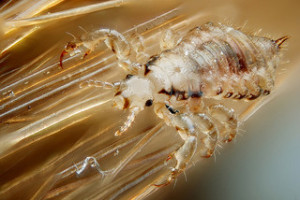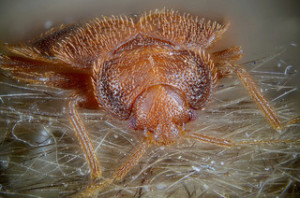What’s the Difference Between Bed Bugs and Head Lice?
By Chris Williams on December 19, 2014.
Over the last year, my daughter’s school has had both head lice and bed bug infestations. What’s the difference between these two pests? Won’t the same methods kill them both? S. L., Hampton, NH

Head louse

Bed bug
From your viewpoint, bed bugs and head lice may seem like almost the same insect but I assure you that from an entomologist’s viewpoint, they are two very different pests. The one thing they have in common is that both are parasites on humans and both suck blood from humans.
They Have Different Habits
One big difference between the two blood suckers is that head lice actually live on their human host, while bed bugs spend most of their time away from their hosts. Head lice remain on the human head, clinging tightly to hairs with specialized claws. They rarely leave their host unless dislodged, or enticed by another head touching the one they’re on, or if repelled by pesticides or special shampoos.
Bed bugs hide during the day in cracks and crevices as close to their host(s) as they can get, and come into contact with people at night only long enough to feed. When a bed bug finishes feeding, it returns to hiding. In schools where there are no beds, bed bugs can be hiding almost anywhere, so a professional inspection is crucial. In a school situation, bed bugs may be enticed to feed during daylight hours.
Neither head lice nor bed bugs spread diseases during their blood feeding, but both definitely cause discomfort, itching, and social trauma for their victims.
Infestations Spread Differently
It’s actually harder to spread head lice than bed bugs. Head lice end up in new locations when they are carried there on a head. But they usually remain on that head and do not infest the new site. Bed bugs can also be carried to new locations but they usually hitchhike on belongings such as purses, tote bags, and backpacks, rather than on people. When bed bugs find themselves in a new location, they look for a hiding place and a new host to feed on at night. Besides being carried to new locations, bed bugs will also walk on their own 6 legs to infest new sites.
Control Methods are Different
To control head lice, you must kill the lice and their eggs (nits) on the person they are infesting. This usually involves shampooing with a pesticidal shampoo, followed by extensive combing. There is no treatment of the premises at all since head lice do not leave their host and crawl around.
On the other hand, bed bug treatment does not involve treatment of the host at all (although it might involve treatment of the host’s bed). Bed bugs are killed by application of insecticide into cracks and crevices, bed frames, and other tight areas where they hide. They can also be killed by certain non-insecticidal methods such as heat or freezing treatments, steam treatment, and specialized vacuuming.
A pest control company’s role in controlling head lice is advisory only. Head lice are a problem to be addressed by parents and school officials, with guidance from medical staff. On the other hand, bed bugs are not a problem that parents, or the school, should try to control on their own. A professional exterminator must be involved in the control aspect, with school administrators doing their part to prevent introduction and spread of bed bugs.
Photo credit: Gilles San Martin / Foter / CC BY-SA
Photo credit: Gilles San Martin / Foter / CC BY-SA
Sign up for our biweekly email newsletter for more information about bugs and pests!